Learning double leg circles on a mushroom
The double leg circle may be the most difficult basic gymnastic skill to learn. The mushroom apparatus was conceived to help beginning athletes develop this skill.
MR-01 River jumps (1-step out, slide feet together and jump)
- Initiating the circle
- Shifting weight 1-hand to both,
- ...eventually the whole circle.
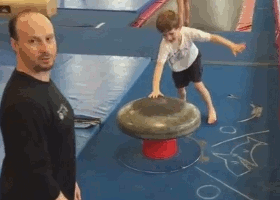
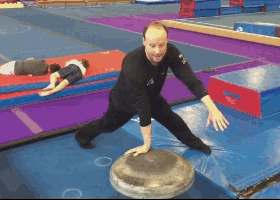

Learning to start a double leg circle; 1-Focus on shifting support weight from the 1st hand, to both hands, then to the other hand. Step away from the circle, then slide the far leg toward the jump leg. This helps create the circle momentum. When the feet touch together, the gymnast jumps into the circle with straight legs and feet locked together.
Circle Jumps (Level 2 Amerikids)
- [MR-02] 4-jump circle,
- [MR-03] 3-jump circle,
- ...eventually the whole circle.
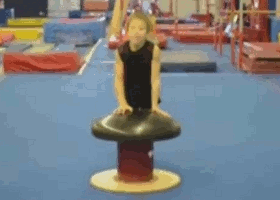
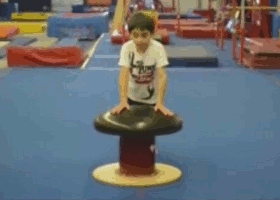
4-hop & 3-hop circle
- 4 or 3 hops
- Feet together
- Hips face forward
- body extended
- 1-hand support on sides
- 2-hand support on front & back
The main focus on the jump circles is to [1]-keep the head & hips facing forward on all of the jumps, [2]-support the body weight on 2-hands in front and back, [3]-support weight on 1-hand (inside) on the sides. On the 3 or 4 jump circle, the jump from 1/2 to 3/4 is difficult for everybody.
MR-04 Sitter circle
- Sitter-1,
- Sitter-2,
- Sitter + Flank dismount
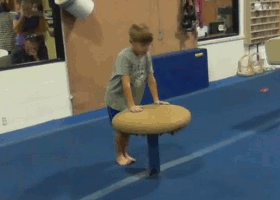
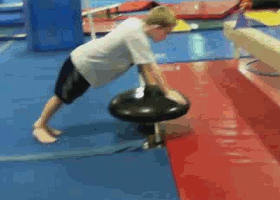
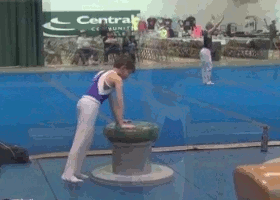
Progress can be slow and both patience and persistence is needed. As speed and hip extension gets better, emphasize faster hands. One, 1+1/2, and 2 sitter circles maximum.
MR-05 Single stretched circle
- To perform use the 1-slide step),
- Feet together
- Stretch hips out in front

To perform a single stretched circle is a huge accomplishment. The hips remain extended and facing forward during the entire circle. The combination of momentum with the proper shoulder lean keeps the legs up off the mushroom.
MR-06 Flank dismount (1/2 Circle with 1/4 turn inward)
- Drawing
- Animated .gif
- Connected or separate
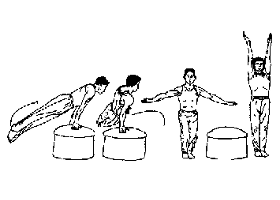

Flank Dismount
- 1/2 circle with 1/4 turn,
- Turn is inward
Emphasize extended hips with a faster circle
- Stretched Circle (1),
- Stretched Circle (2),
- Bucket forearm circles (3)
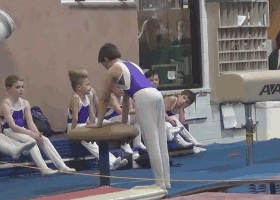
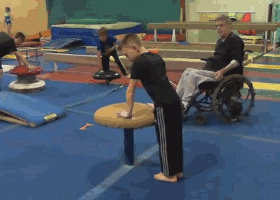
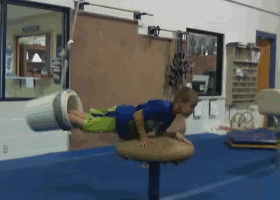
Common Error #1
Don't let the slide step foot pass the other leg and lead the body on the circle. Progress will be different for each athlete. Persistance and determination is developed by this type of skill in the sucessful athletes.
Common Error #2
Don't lift the hip too high when starting the first 1/2 circle.
Common Error #3
Turning the hips back to forward quickly on both half circles enable the hand placements and weight shifts to an even rhythm. Forearm circles in a bucket help the athletes learn to extend their body on all sides.
When you reach the 1-clean circle plateau, you will still be fixing form problems and late hip shifts. (1) Feet not together on take-off, (2) Little bit high on one-side will cause a low body on the opposite side, and (3) the hip position in front and back will affect the hand placements and tempo. It is common when that the lead hand will creep forward and recovery hand will drift backwards.